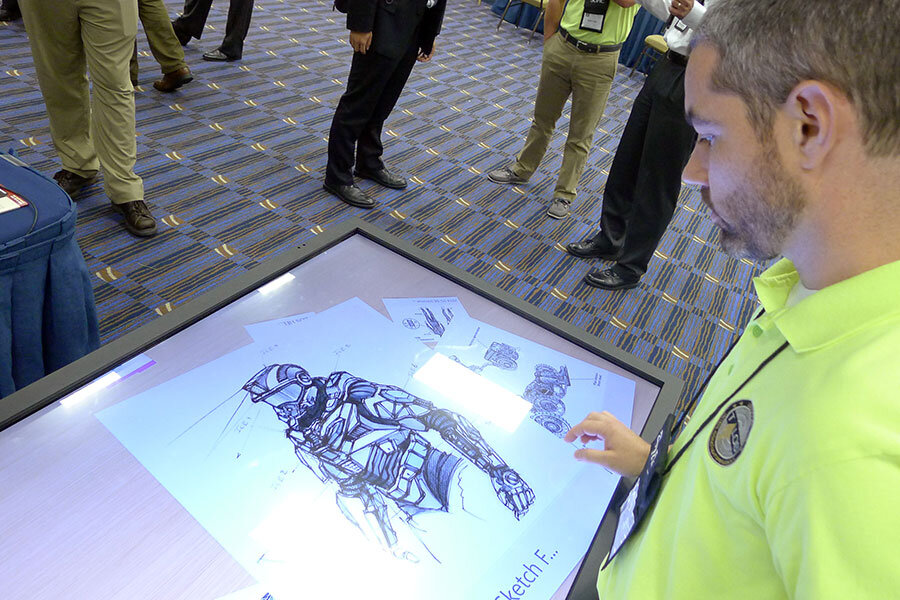Why does the Pentagon need an Iron Man suit?
Loading...
| Washington
When the head of United States Special Operations Command said recently that he hopes his troops will someday soon be wearing super-light, super-strong exoseletons known affectionately as “Iron Man” suits, it might have sounded like a bit of classic Pentagon excess.
Cool, but outrageously expensive and a bit of a luxury item.
Then Special Forces Operatives like Paul Scharre share their experiences – in Mr. Scharre's case of coming upon a nest of Taliban at dawn in the mountains of Afghanistan – and the request begins to make more sense.
Sure, the body armor he was wearing was a “big advantage,” as were the night-vision goggles, but all told, the members of Scharre’s sniper team each had to lug 160 pounds of gear up a mountain.
WIth the small, elite team quickly outnumbered, “all of a sudden, all that stuff that we carried up and thought was so great” became a liability, says Scharre, who served as a special operations reconnaissance team leader in the Army’s 3rd Ranger Battalion, completing multiple tours to Iraq and Afghanistan. “We did that once and said, ‘That was a mistake.’ ”
That is what makes things like exoskeletons, which help troops bear heavy loads, “really appealing,” he says.
The technology requests by Special Operations Command generals still sound decidedly Buck Rogers, such as self-healing computer networks that can repel cyberattacks and “comprehensive signature management” systems that provide stealth for ground troops by masking they ways they could be remotely detected. And they would require an enormous budget outlay.
But at a time when America’s primary mode of warfare is counterterror operations, they point to the frontiers of that war. And with special operators being sent on many of the most dangerous missions – whether in war or peace time – the requests often have an imminently practical element: They aim to save the lives of troops who are being sent directly into harm’s way.
For Scharre, now a senior fellow at the Center for a New American Security, the lists are about trying to give America’s on-the-ground fighters the same advantages that technology has given its airmen and sailors.
Back in World War II, the three most dangerous jobs were bomber pilots, submariners, and the infantry, he says. In the years since, the US has leveraged technology to increase the survivability of bombers and submarines. “We built stealth bombers that no one else has, and the very best submarines,” he notes.
But infantry combat hasn’t changed fundamentally since World War II, Scharre argues. “You grab someone who operated on the beaches of Normandy, you show them how to use an M4 [rifle], and there’s a level of parity that isn’t very different.”
It’s the same level of parity that US forces have encountered in Afghanistan. “All of the whiz-bang technology hasn’t had the same effects on the ground,” Scharre notes. “In a shootout we’re pretty evenly matched against guys carrying AK-47’s and wearing flip flops.”
That is the potential appeal of so-called “human performance enhancers,” like the Tactical Assault Light Operator Suit (TALOS) exoskeleton – or Iron Man suit.
The hope is to “bring technology to bear in ways that we haven’t quite done for ground warfare yet,” he says.
Small drones that can follow elite ground units around like devoted winged puppies are also “super appealing,” he adds. Commercial technology allows snowboarders, for example, to wear a wrist tracker that allows small aerial drones with cameras to follow them, garnering great footage.
Something similar would work well for US forces – to peer around buildings and hillsides to get eyes on the enemy.
“I remember in Iraq we lost a whole squad of troops wounded or killed because somebody in a suicide vest came around a corner,” Scharre recalls. Such a drone would have prevented that – and, equally important, forces wouldn’t have to carry them around.
But that means creating a longer battery life and more funding. Of the services, Special Operations Forces are the least cash-strapped, and among the most able to think in terms of occasionally outlandish, gee-whiz technology.
That’s because counterterror operations have made Special Operations so in demand by US military commanders. “I think we have been extraordinarily well-supported by Congress; we’ve been extraordinarily well-supported by the [Defense] Department,” General Votel told a Special Operations conference in Washington last week. “When I look at this year’s budget, we did pretty darn well.”
That has the potential to impact all ground forces. Since small teams are a trademark of Special Forces, they can more agilely field experimental equipment, to try out new body armor, exoskeletons, and other high-tech gear to see how it works.
From the most elite special operators to the general forces, Scharre says, “It filters down.”






